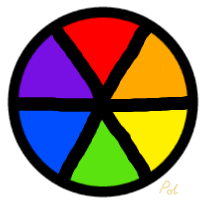
Usually covers have a limited colour scheme, using shades of one colour, two colours that work together (either because they’re close together or dramatic opposites), or a bold tri-colour scheme using the primary colours. This is mainly because it’s very easy to make rainbows look like a unicorn vomited on the book.
Which is all very well, but the theme for my collection is rainbows, so an all-green cover wouldn’t exactly fit (no matter how lovely). I want to avoid any of the unicorn-vomit pitfalls, but I also want a rainbow. So before starting my own cover, I looked at other artwork using rainbows. These are my thoughts about using that colour scheme effectively.
Rainbow Rules
My first step was a visit to Google images. I searched for terms like “rainbows” and “rainbow lights”. A few observations on the pictures that came up are as follows:
- Some images used the vomit method on purpose, such as psychedelic artwork and digitally edited photos of rainbows. These are intended to overload the viewer. There’s nothing wrong with that, but for a book cover, it’d detract from the details you want the viewer to see (the title and the author).
- For non-psychedelic works, the most effective had de-saturated backgrounds, such as black, grey or a greyish shade of a colour. This made the rainbow stand out and also solved the visual overload problem. White backgrounds were also used for a brighter feel, but the rainbow stood out less against them.
- Some focused mainly on one or two colours, with only small amounts of the rest. This gave the feel of the rainbow, without too much of a colour explosion.
- The central colour would often appear to dominate at first glance, even if it was in the same quantity (or less) than the rest.
- For contrasting areas, some used rainbow opposites. What I mean by this is they’d pair the opposite ends of the rainbow – red and violet. Usually in art, you’d use the opposite on the colour wheel* for this sort of contrast (which would be red opposite green, and violet (purple) opposite yellow). Red and purple wouldn’t be considered to have this sort of contrast, as they’re next to each other on the wheel. However, in a rainbow, the viewer has the expectation that red and purple are opposites, so odd though it is, it works (as long as the picture sufficient screams “rainbow”).
- Realistic rainbows had more subdued colours for the rainbow itself, because in the real world, rainbows aren’t generally that bright against the sky. Sometimes it’s good to remember that you don’t have to set saturation to maximum when editing a rainbow picture.
- Rainbow lights often had darker shades of the colour at the edges, with highlights in a bright/light shade. Most of these in the image search were photographs of lights, but the principle would work for a painted image too.
Cover Examples
After looking at rainbow images in general, I found book covers with rainbow colour schemes, and analysed which techniques they used (and how well).
Meant to Be – Lauren Morrill
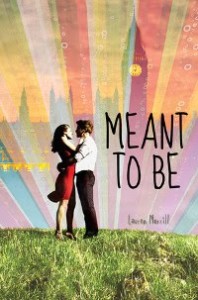
The cover takes an inspiration from natural rainbows, both in having the rainbow in rays like a sun, and having a scene in the foreground. There are colours in the scene, but they’re somewhat muted (note the red dress is not that bright, and has been mostly shadowed out… the grass is somewhat de-saturated). It’s focused on reds and yellows, which goes with the feel-good contemporary novel blurb. It’s also used some rainbow opposites to show the city against the sky.
It does a decent job of implying a groovy psychedelic theme, without going into eye-bleeding territory. The thing I least like is the font choice, but that’s not a colour issue. It’s certainly readable.
The End of the Rainbow – V.C. Andrews
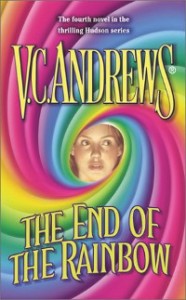
Not only did a unicorn have an accident here, but the magic turned it into a rainbow-vomit whirlwind, which ate the protagonist! Also, the title is in a similarly bright colour so there’s no real contrast. Add in the blurb, which talks about devastating tragedies, secrets and hardship, and someone had too many skittles.
In terms of colour balance, red was shifted to pink, and the yellow/green part is smaller than the rest (possibly in an attempt to make the yellow title text stand out a little more). This wasn’t a successful cover, and it doesn’t surprise me they changed it for the newer version (the new cover barely has any rainbow on, so I won’t be looking at it).
Arclight – Josin L. McQuein
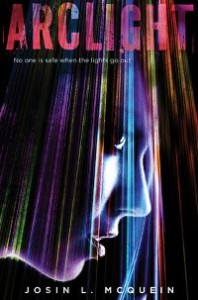
The black background makes the light beams stand out, with white to outline the face without drawing away from the rainbows. A focus on purples and blues is common for speculative fiction, and has been used to good effect here.
Rainbow opposites were used for the title, making it stand out, but also fit with the rainbow theme. It uses the same patterning as the lights, linking the title to the picture.
Crewel – Gennifer Albin
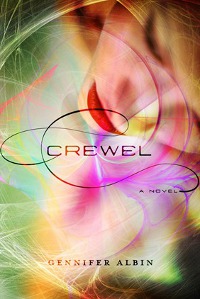
Another speculative book with a different approach. One trick here is the extremes have been minimised. There’s only a hint of violet, indigo and blue. Red is softened to pink for most of it. Saturation has also been used – most of the background colour is less saturated (more subtle than using a grey background, but it’s still there). The swirls are the most saturated parts, and draw the eye (the focal point of those being near the centre, close to the title).
I liked the choice of the pink swirls and red lips as the central colours. It’s playing with cover colour stereotypes, as such colours are usually put on chicklit books. But it’s using them in different ways, with an overall composition that’s more dreamlike and suggests a speculative book. This goes with the blurb about becoming a beautiful and deadly spinster.
Much like Arclight, the title interacts with the picture. It’s dark, so it stands out, but has reddish sections where it crosses the picture.
My Plans
My original idea was a rainbow squid in a black ocean. Arclight was very close to my colour scheme ideas, so I’ve seen it can work.
The debatable point is how bright to make the squid. It could be lit up, as though it’s self-illuminated. It could also be fairly dark, as though a light is being shone onto it. Or a mix of both, with small points of light. As the squid body will take up a fair bit of the cover, I’m leaning towards a darker approach, with some points of light.
Colour-wise, purple/blue is often associated with speculative work, so would be a sensible dominate colour scheme. I liked Crewel‘s play on the cover colour stereotypes, but it’s more of a risk for self-published work. Making the genre easier to identify increases the chances of a reader looking at the book.
I preferred the covers where the title and the picture went together. Meant to Be worked as far as the picture was concerned, but the text seemed separate, as though it was an afterthought. But this decision can come a little later, as I’ll be adding the title digitally. The next step will be drawing the squid, which is a story for another post.
–
* See the top of the post for a picture of a basic colour wheel.